Technologies developed by researchers at the Department of Energy’s Oak Ridge National Laboratory have received six 2023 R&D 100 Awards.
R&D World magazine announced the winners from their selection of finalists announced last week. The winners will be recognized at the organization’s award ceremony November 16 in San Diego, California.
“ORNL strives to deliver technological solutions for the nation’s toughest problems,” said interim ORNL Director Jeff Smith. “This year’s R&D 100 Awards are a reminder of how hard our scientists and engineers work to accomplish that feat.”
Often referred to as “The Oscars of Innovation” and the “Nobel Prize of Engineering,” the R&D 100 Awards has for the last 60 years honored science and technology research and development leading to new commercial products, technologies and materials that are available for sale or license. The winning technologies and their developers are the following:
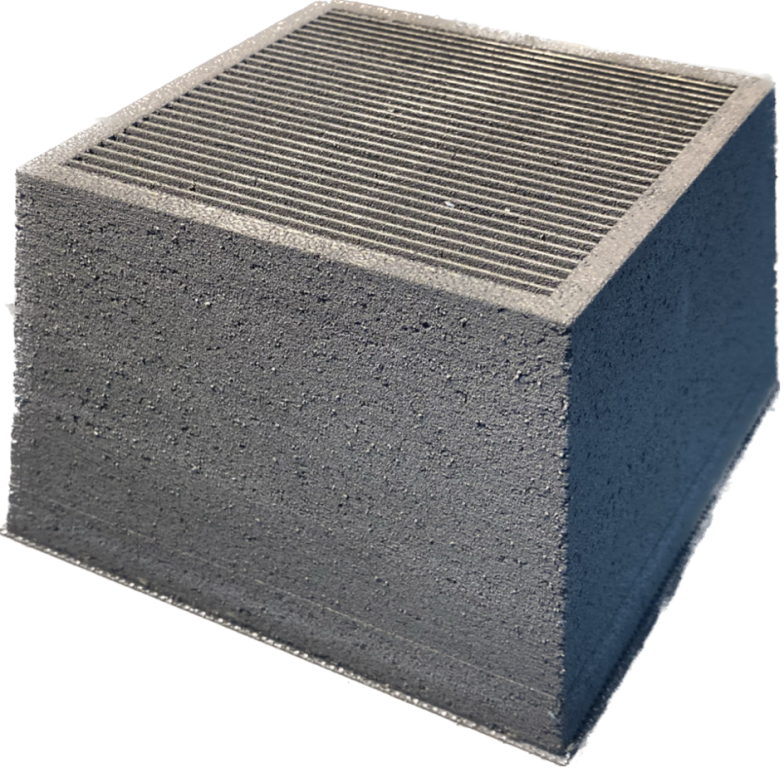
Additively Manufactured Thermally Conductive Collimators for Neutron Instrumentation, developed by ORNL and PolarOnyx.
Researchers from ORNL and PolarOnyx, Inc., have developed 2D and 3D collimators and parts using aluminum-boron carbide matrix composite-based manufacturing. Collimators are essential components for neutron and x-ray experiments as they reduce background so that only neutrons and x-rays scattered from a sample are measured. The metal matrix composite, or MMC, additive combines the large neutron absorption cross-section and hardness of boron carbide with the high thermal conductivity of aluminum to provide robust, low-noise neutron scattering measurements.
These complex collimators offer significant improvements over traditionally manufactured collimators with unprecedented neutron scattering test performance, and the MMC additive manufacturing technique allows for reduced maintenance costs and production times.
DOE Office of Science provided funding for this research.
Development was co-led by ORNL’s Matthew Stone, Jeff Bunn, Andrew May and PolarOnyx’s Jian Liu and Shuang Bai. Alexander Kolesnikov and Victor Fanelli from ORNL contributed to the development.
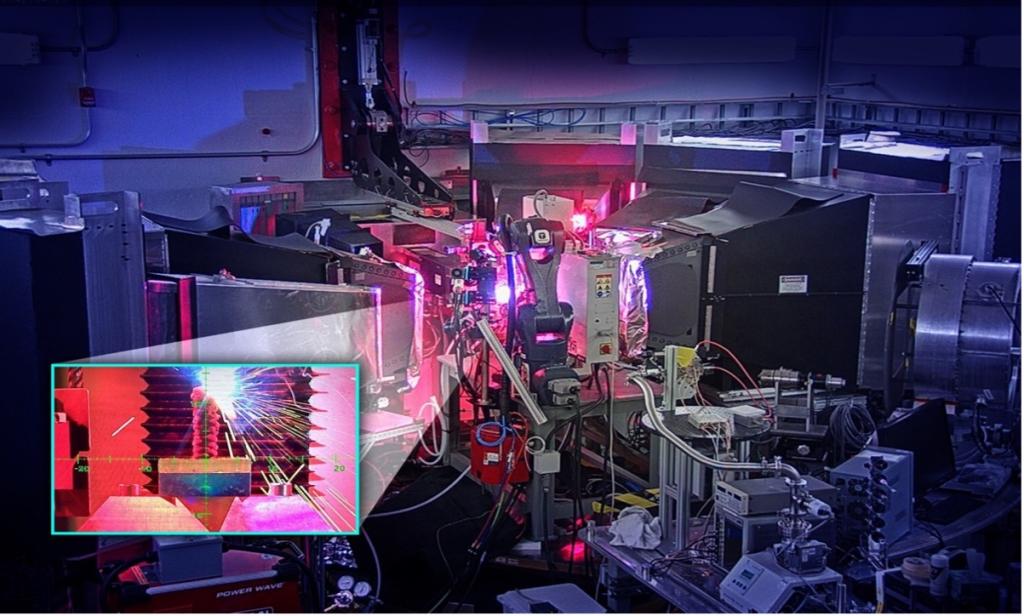
OpeN-AM: A Platform for Operando Neutron Diffraction Measurements of Additive Manufacturing, developed by ORNL.
ORNL researchers have developed OpeN-AM, a platform for performing operando neutron diffraction studies of metals during additive manufacturing, or AM, also known as 3D printing.
The platform consists of a deposition head, machining capabilities and IR, or infrared monitoring. All of which can be coordinated with operando engineering neutron diffraction measurements with the VULCAN beamline at the Spallation Neutron Source, or SNS, at ORNL.
This combination of capabilities provides unparalleled insight into the evolution of phase transformations and stressors that occur during the AM process. These new insights allow for continued improvement of AM processing to mitigate stressors and accelerate development of new materials and process strategies.
Funding for the research was provided by DOE Laboratory Directed Research and Development, Digital Metallurgy Initiative.
Alex Plotkowski from ORNL led development with Chris Fancher, Kyle Saleeby, James Haley, Ke An, Dunji Yu, Tom Feldhausen, Guru Madireddy, Yousub Lee, Joshua Vaughan, Suresh Babu, Jessie Heineman, Clay Leach, Wei Tang and Amit Shyam from ORNL assisting in development.
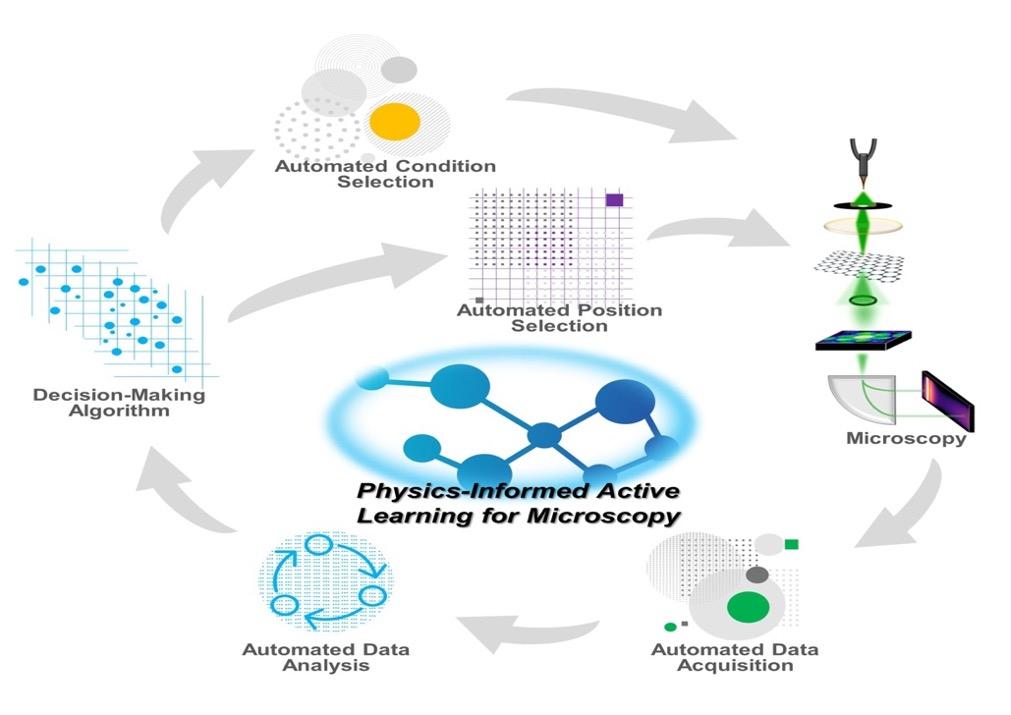
Physics-Informed, Active Learning–Driven Autonomous Microscopy for Science Discovery, developed by ORNL.
Researchers from ORNL and the University of Tennessee, Knoxville, have created a physics-informed, active learning method for autonomous experiments. This software suite is composed of active learning algorithms, control software for microscopes and other experimental tools that expedite scientific discovery.
The advancement of microscopy has transformed the way scientists and researcher study materials and biological systems. However, there are multiple challenges in developing autonomous microscopy including automating microscopy (such as automating data acquisition and transfer protocols), development of task-specific machine learning methods, understanding the interplay between physics discovery and machine learning and end-to-end definition of workflows.
The research addresses current challenges in enabling autonomous microscopy workflows by balancing the required physical intuition, prior knowledge of scientists and experimental goals with machine learning algorithms capable of translating these to specific experimental protocols.
Funding for this project was provided by DOE Office of Science.
Co-development was led by ORNL’s Yongtao Liu and Maxim Ziatdinov with Sergei Kalinin from UT Knoxville. ORNL’s Kevin Roccapriore, Rama Vasudevan, Kyle Kelley and Stephen Jesse contributed to development.
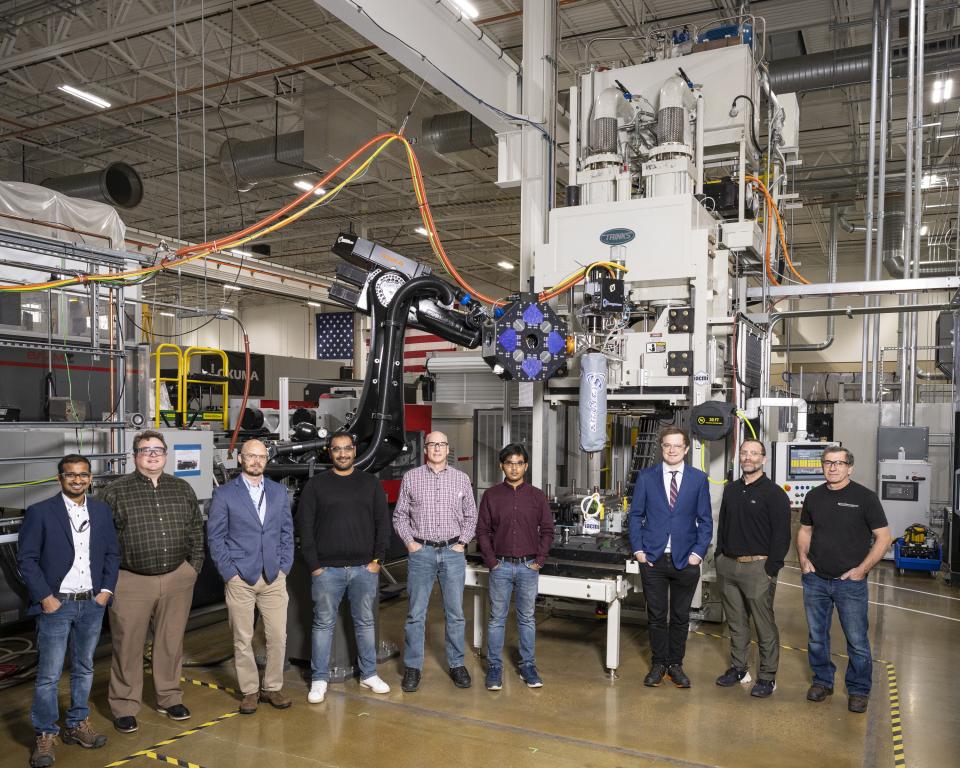
Precise, Continuous, & High-Speed Manufacturing of Thermoplastic Composites Using Additive Manufacturing-Compression Molding, AM-CM, developed by ORNL.
Researchers at ORNL have created a highly automated process for thermoplastic composite manufacturing that combines the benefits of additive manufacturing, or AM, and compression molding, or CM, to produce a high-performance functional composite structure at automotive production rates.
The AM-CM process combines the best attributes of conventional processes to produce composite parts. AM deposits reinforced polymers, in which fibers are uniformly dispersed and oriented in the optimal direction, and CM removes voids while imparting a smooth finish.
This process addresses shortcomings in existing advanced additive and traditional processes while retaining their desirable features and has the potential to become a dominant manufacturing process for polymers and composites.
DOE’s Office of Energy Efficiency and Renewable Energy, Advanced Materials and Manufacturing Technologies Office (AMMTO) provided funding for this research.
Development was led by ORNL’s Vipin Kumar with ORNL’s Vlastimil Kunc, Ahmed Hassen, David Nuttall, Seokpum Kim, Deepak Kumar Pokkalla, Paritosh Mhatre, Bill Peter, Craig Blue and Joshua Vaughan assisting in development.
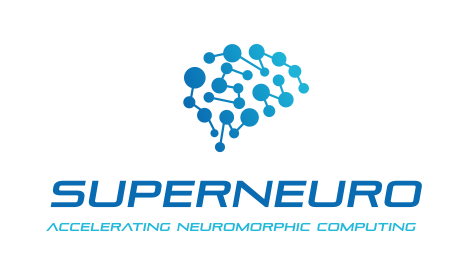
SuperNeuro: An Accelerated Neuromorphic Computing Simulator, developed by ORNL.
To address the current limitations and inefficiencies that limit large-scale neuromorphic computing, researchers at ORNL created SuperNeuro, a Python-based open software that provides AI practitioners with brain-like simulators that are fast and scalable on central and graphics processing platforms. Using matrix-based and agent-based modeling approaches, SuperNeuro allows for different workloads and provides the option of simulating the user’s own spiking mechanisms in a human-interpretable manner.
Compared with existing simulation platforms, SuperNeuro provides an indispensable neuromorphic software with increased adaptability, leveraging GPU computing to provide superior performance for neuroscience, spiking neural networks, or SNNs, and general-purpose computing workloads. Easy integration with other tools for SNN optimization opens the possibilities for codesign of neuromorphic circuits. SuperNeuro can be up to 300 times faster than other simulators for small sparse networks and up to 3.4 times faster on large sparse and dense networks.
Funding for this project was provided by DOE Office of Science.
ORNL’s Prasanna Date, Shruti Kulkarni and Chathika Gunaratne co-led the development. Research contributors included, ORNL’s Robert Patton, Mark Coletti and Thomas Potok.
ORNL also supported the development of CANDLE (CANcer Distributed Learning Environment), a 2023 R&D 100 Award winner in the Software/Services category. CANDLE is a collaboration with multiple DOE laboratories and Frederick National Laboratory for Cancer Research for an open-source software platform that provides deep learning methodologies for advancing cancer research.
UT-Battelle manages ORNL for the Department of Energy’s Office of Science, the single largest supporter of basic research in the physical sciences in the United States. The Office of Science is working to address some of the most pressing challenges of our time. For more information, please visit energy.gov/science. — Gabriela Vara

